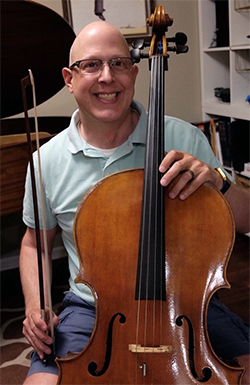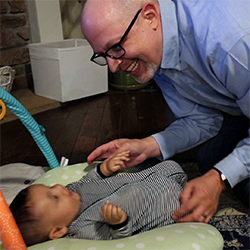Saving a Patient’s Voice
A team approach to laryngeal cancer
By Tyler Smith
(November 2019) Michael Rector was hoarse but was sure he knew why.
It was November 2016 and Rector, then 39, had just spent a few days at a Microsoft conference he attended with fellow information technology specialists. The toll of working hard and playing hard was a raspy voice, he thought.
“I talked too much with colleagues, drank a little too much, ate rich food, and stayed out late,” Rector recalled.

through music on the cello and other
instruments.
Photo courtesy of Michael Rector.
Rector thought he’d be back to normal in a couple of weeks, but his mouth and throat remained stubbornly dry. He finally decided to see an ear, nose and throat specialist near his home in Parker. The physician used a laryngoscope to examine Rector’s vocal cords (larynx) and the area around them and prescribed steroids and antibiotics to reduce inflammation.
But the hoarseness persisted, and two weeks later, Rector was back in the ENT’s office. A second laryngoscope exam brought news he wasn’t prepared for: his physician had seen nodes on Rector’s vocal cords and wanted to schedule surgery as soon as possible.
“It was a level of urgency that was completely unexpected,” Rector said.
DISEASE JOURNEY, PART ONE
A biopsy ultimately revealed that a malignant tumor called spindle cell carcinoma had invaded Rector’s vocal cords— two folds of tissue less than an inch long whose vibrations produce speech and other sounds. From a disease standpoint, Rector was breathing some unwanted rarified air: spindle cell carcinomas make up a tiny fraction (1 percent to 3 percent) of all laryngeal cancers.
“I was thinking, ‘What a way to go into the holidays,’” Rector said.
The emotional twists and turns of November 2016 grew sharper for Rector over the next two years. He faced difficult clinical and emotional decisions that produced a gamut of emotions and insights.
After receiving his initial diagnosis, Rector and his wife Abbey searched for cancer specialists and ultimately decided to get their care at the University of Colorado Cancer Center on the Anschutz Medical Campus. He received six weeks of radiation treatments at the UCHealth TomoTherapy Cancer Clinic in Lone Tree with David Raben, MD, and Ryan Lanning, MD, PhD, radiation oncologists and professor and assistant professor, respectively, in the Department of Radiation Oncology at the University of Colorado School of Medicine. The treatments used 3D imaging to precisely target the tumors with radiation and spare healthy tissue to the greatest extent possible.
Rector, a self-described “horrible workaholic,” got his treatments first thing in the morning, then headed straight to his job. The radiation put his voice out of commission, but he worked from home and used email and instant messaging to communicate. Rector finished his radiation treatments in February 2017, and four or five months later, his voice had recovered and he was “talking up a storm.”
DISEASE JOURNEY, PART TWO
The seemingly smooth recovery derailed in spring 2018, both clinically and personally. Rector’s follow-up care included monthly laryngoscopies to look for signs of his cancer returning. He worked with John Song, MD, and Daniel Fink, MD, of the UCHealth Ear, Nose and Throat Clinic and respectively, associate professor and assistant professor of the CU School of Medicine Department of Otolaryngology, hoping to improve his voice even further through laser surgery to remove tissue scarred by the radiation treatments.
Fink said he uses laser technology in laryngeal cancer surgery because of its precision in cutting away diseased tissue and minimizing bleeding.
“You can see planes of tissue and can see when you’ve gotten through the tumor and into healthy tissue,” Fink said.
“I was ready to push the envelope and clean up the scarring,” Rector said. Fink did so, but after the surgery, biopsies of the tissue showed that Rector’s cancer had come back.
He faced the prospect of a total laryngectomy – daunting enough, but there was an added twist. He and Abby had recently learned she was pregnant for the first time. An avid musician and singer, Rector had thought with pleasure of strumming his ukulele and singing to his baby. Losing his vocal cords would put that dream to rest, as well as any thought of scuba diving, which he pursues avidly. But those thoughts only scratched the surface of his fears.
“More than anything, I want to be around for my baby, but what does that look like?” Rector wondered. “What is the impact on my day-today life and work? I’m very social and talk a lot to friends. Am I going to run into depression and become a hermit because I’m embarrassed to be in society?”
He found he didn’t have to confront his anxiety alone. He visited Juliana Litts, a speech-language pathologist with the ENT Clinic at UCHealth and assistant professor of otolaryngology, who offered him support and explained how he could learn to use his esophagus to speak if he lost his vocal cords.
“She let me know I wouldn’t have to give up being a functioning member of society,” Rector said.
SAVING THE VOICE
Meanwhile, Fink and Song took his case to a tumor board at the CU Cancer Center to consider the options.
“The knee-jerk answer was a total laryngectomy,” said Fink, who wasn’t satisfied with that solution. He and his colleagues decided instead to recommend using surgery to aggressively remove the cancer from the framework of the voice box, while saving as much of Rector’s vocal cords as possible.
The decision wasn’t an easy one. Speaking of laryngeal cancer generally, Fink said surgeons cannot provide one-size-fits-all solutions for patients.
“If the cancer is in the vocal cords themselves, the issue is that the more tissue we take to be sure the patient is cancer-free, the worse the voice may end up afterwards.”
Fink said he considers the size of the cancerous lesion and the clarity of its boundaries in the tissue. Other factors include how much a patient relies on speaking, age, and risk of the cancer spreading. Patients like Rector who have had one round of radiation generally aren’t candidates for another because the treatment can tighten muscles with fibrous tissue.
There is also the inherent uncertainty of how cancerous cells insinuate themselves in the vocal cords.
“Once we are in there, we have to cut until we are around the tumor,” Fink said. “Sometimes it can be deeper than you think. If somebody needs their voice for living, then I may be less inclined to offer surgery if I’m not confident that I can cut around the tumor in a very limited fashion. We take an individualized approach to lesions.”
In Rector’s case, images of his larynx, the tissue above it known as the false vocal cords, and the ventricle separating the two convinced Fink and his colleagues that surgery to remove the tumor while sparing part of both vocal cords was a viable choice.
A LONG ROAD
Rector consented to the salvage-surgery approach, which meant multiple procedures. “I said let’s do a little bit at a time. I’m willing to go down that path before doing an all-out cutting out my larynx,” he said.
The work resulted in two additional surgeries. Fink first lasered away cancerous tissue in the front half of the left vocal cord. After about three recovery weeks for Rector, Fink cut cancer from the front half of the right vocal cord.
The surgeries wrapped up at the end of July 2018, and Rector got monthly imaging tests to monitor the repaired area. There remained a couple of questionable areas involving radiated tissue, so he elected to undergo yet another procedure to retrieve a
sample for biopsy. Rector endured an anxious wait before he got Fink’s call: the biopsy showed no recurrence of the cancer.
The news was an obvious relief for Rector, but he also immediately thought of Fink, who had put so much painstaking
effort into clearing the cancer and saving as much of Rector’s vocal cords as he could.
“I didn’t want the cancer to come back for my sake,” Rector said. “But I didn’t want it to come back for his sake as well.”
STILL SPEAKING
What of his voice? It’s raspy but perfectly understandable. And the fact that he produced it surprised Fink and Marie Jetté, a UCHealth speechlanguage pathologist and assistant professor of otolaryngology, during a follow-up visit at the UCHealth Lone Tree Medical Center.

son Theodore, born last November, after
surgeries tamed his cancer and salvaged
part of his vocal cords.
Photo courtesy of Michael Rector.
When Rector told them he felt his voice was making a strong comeback, Jetté told him he was vibrating his false vocal cords in order to speak—despite the fact that neither she nor anyone else had taught him how to do it.
“I have been pleasantly surprised by Michael’s finesse with using ventricular phonation (vibration of the false vocal folds as a sound source),” Jetté said in an email. “People who have had such extensive laryngeal surgery and radiation like Michael do not often have the excellent voice communication outcomes that he has achieved completely of his own accord.”
For his part, Rector only can guess that his untrained facility comes from learning to manipulate his breathing as a flute player and as a vibrato-generating singer before the cancer diagnosis.
“I learned to make my throat do various things,” he said. “My throat might be more malleable than the average person’s.”
His throat is also capable of doing that thing Rector imagined when he learned he was a father-to-be. On November 2, 2018, he and Abby welcomed son Theodore into the world. Rector can whisper his way through “The Itsy-Bitsy Spider” and a few others to a tiny listener who knows nothing of cancer, only the soothing sounds of a familiar voice.
“I went from being a tenor with close to a three-octave range to something that can’t be described as a tenor with about a one-octave range,” Rector said. “I won’t be singing Paganini any time soon.”
He doesn’t sound concerned. He’s got his family and can still make music with his ukulele and flute, as well as guitar, piano, and cello, his current favorite.
NEW PERSPECTIVES
For now, Rector remains cautiously optimistic that the radiation and surgeries have banished the disease for good. “We’ll continue to watch and wait and hope that the insidiousness of the cancer doesn’t rear its head at some point,” he said.
Yet he knows that cancer has had a permanent effect on his life. There is his voice, of course. But the lessons go deeper. He talks of gaining a fuller appreciation of his mortality and feeling a connection with others who have faced the same fears he did when confronted with cancer.
“Until you’ve tasted what it feels like to not know if this is going to be thing that kills [you], you don’t know how to talk about that to people,” he said.
“From a faith perspective and from a societal perspective [cancer has] given me knowledge that I wouldn’t have wanted to have, but I’m glad that I have it now,” he added. “I’m a totally different person and better for it. It destroys ego. Ego and cancer are incompatible.”
This article originally was published in UCHealth Today.